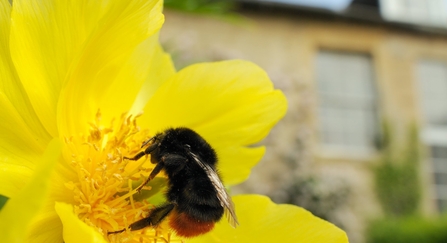
Queen Red-tailed bumblebee (Bombus lapidarius) feeding on Yellow tree peony (Paeonia ludlowii) flower in Wiltshire garden, with Clematis covered house in the background, UK, April. - Nick Upton/2020VISION

Queen Red-tailed bumblebee (Bombus lapidarius) feeding on Yellow tree peony (Paeonia ludlowii) flower in Wiltshire garden, with Clematis covered house in the background, UK, April. - Nick Upton/2020VISION
Bumblebees, solitary bees, butterflies, moths, wasps and flies – you’re bound to see these pollinating insects feeding on flowers at the moment, whether in your garden or in the local park. We're calling on Cumbrians to record as many of these pollinating insects on a single day – Wednesday 3 June - to build up a picture of how many there are, where they are found and what we can do to help them.
Lucy Graham, Project Officer for Get Cumbria Buzzing explains what’s involved: “We’re asking you to take pictures of the different insects you see feeding on flowers on Wednesday 3 June. This could be over the course of an hour or even over the whole day! We’d like you to take photos of the pollinators – it doesn’t matter if you don’t know what they are - but try to include as much of the insects as possible in the photos, and upload them onto the iNaturalist app – it’s that simple!”
Lucy continues: “We’ll have a team of experts on hand between 9.30am and 4.30pm to verify your recordings, but you can upload your photos at any point during the day. The idea is to record as many different insects feeding on flowers as possible. If you upload images outside this time, don’t worry, your records will still count, and we will verify them as soon as we can!”
Whether you’re in your back yard or garden, or out and about on a walk on Wednesday 3 June, we'd like you to help us record as many pollinators in Cumbria as we can. Anyone can take part, including children if they have an adult to help them. You’ll need a mobile phone with a camera and access to the internet.
Lucy explains why this survey matters: “Our pollinating insects are in trouble - more than half of UK bee, butterfly and moth species have declined in the past 50 years, and 30 species of bees face extinction. Your records will give valuable data to local and national biodiversity record centres. With your help, we’ll be able to create the first Cumbrian Pollinator Atlas and will be able to track insect populations and movements. This important information will help tell us the best ways to support pollinators across the county.”
To take part, download the iNaturalist app (available via Google Play or App Store).
Then, all you need to do is:
For more information, email lucyg@cumbriawildlifetrust.org.
With your help, we’ll be able to create the first Cumbrian Pollinator AtlasLucy GrahamProject Officer, Get Cumbria Buzzing
Get Cumbria Buzzing is a ground-breaking, three-year project which aims to get parks, school grounds and other green spaces around north and west Cumbria buzzing with bees and pollinators. Cumbria Local Nature Partnership is working with Highways England and Cumbria Wildlife Trust to get local people buzzing with activity to boost numbers of bumblebees and other wild pollinators and halt their decline.
Cumbria Local Nature Partnership and Cumbria Wildlife Trust are bringing together a wealth of experience including Allerdale Borough Council, Buglife, Butterfly Conservation, Copeland Borough Council, Cumbria Biodiversity Data Centre, Florence Arts Centre, Highways England, National Trust, Solway AONB and Workington Nature Partnership.
This £1.6 million project is made possible by National Lottery Players and support from the National Lottery Heritage Fund, Highways England, Cumbria Waste Management Environment Trust, Rees Jeffreys Road Fund, Tesco, Allerdale Borough Council, Solway Coast AONB and The Hadfield Trust.
Administered by Cumbria Community Foundation, the following organisations are also funding the project: Fairfield Wind Farm Community Benefit Fund, Robin Rigg West Cumbria Fund, Winscales Moor Community Benefit Fund and United Utilities Legacy Fund.